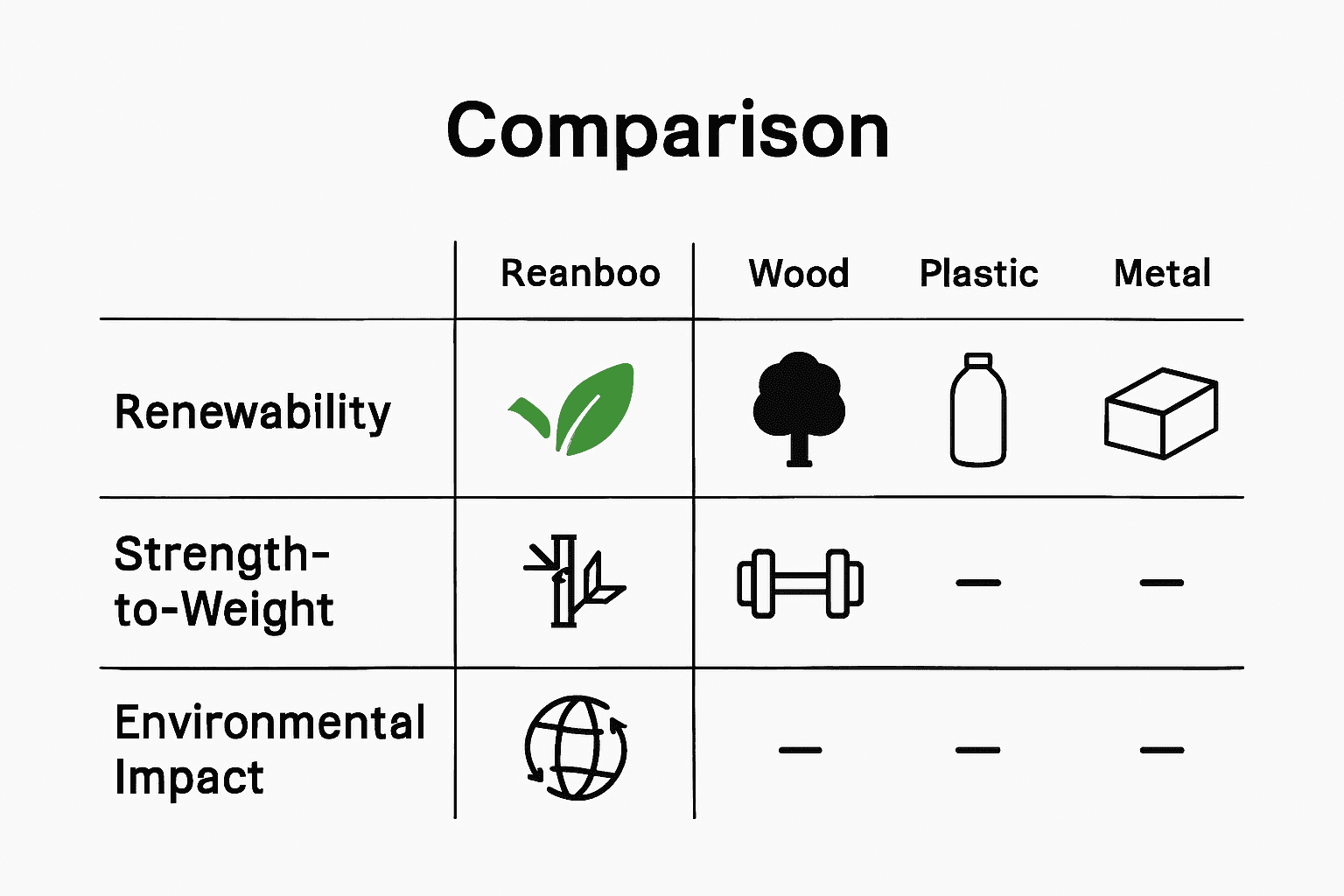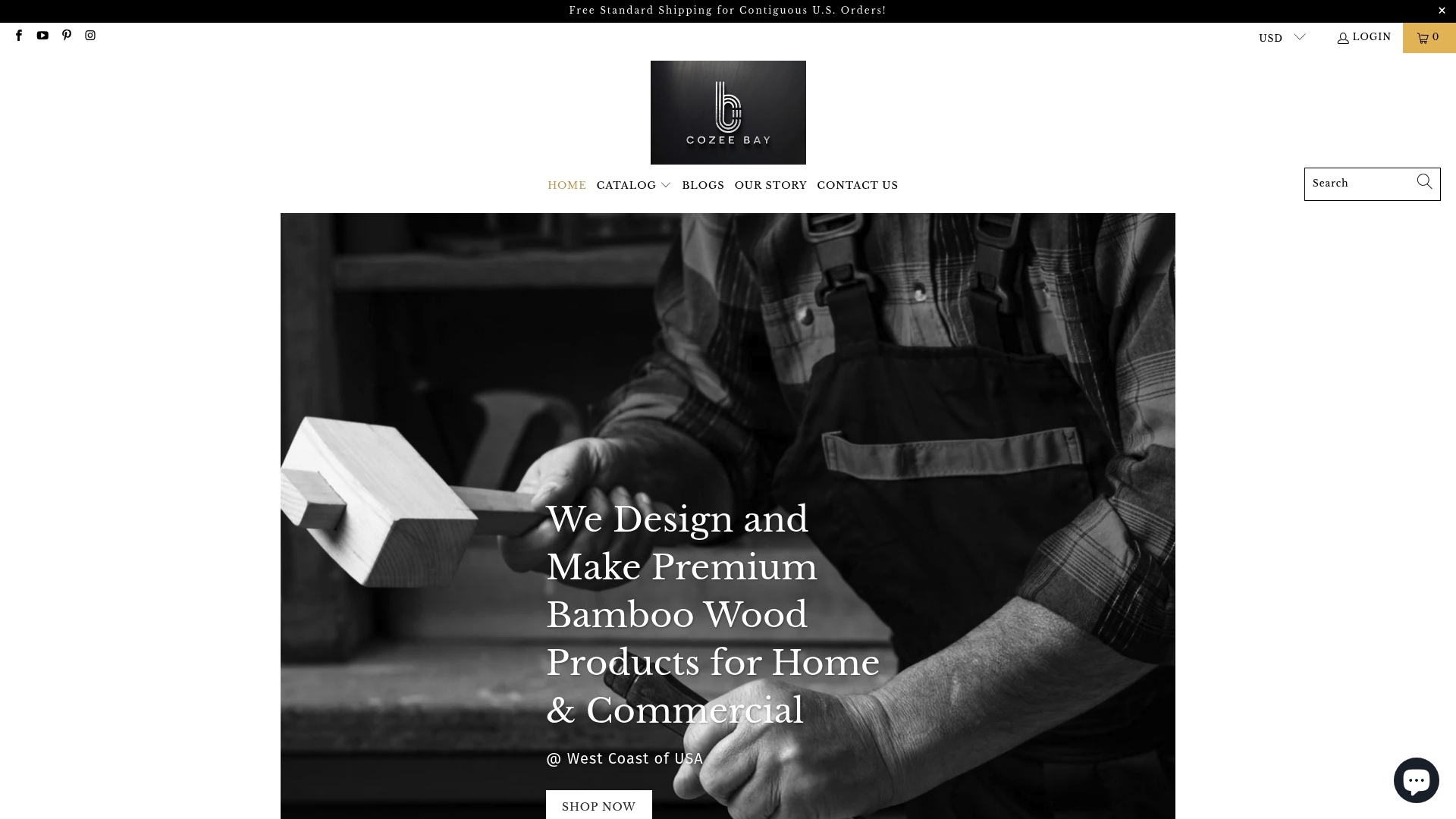Your Cart is Empty
Free Standard Shipping for Contiguous U.S. Orders!
Free Standard Shipping for Contiguous U.S. Orders!
Catalog

What Is Modern Bamboo Design? Complete Overview
October 17, 2025 6 min read
Did you know that bamboo can grow up to 1 meter in a single day? This rapid growth makes it one of the most sustainable resources on the planet. As architects and product designers push for greener solutions, bamboo stands out with unmatched strength, versatility, and eco-friendly benefits. Discover how innovations in modern bamboo design blend nature’s intelligence with scientific precision to redefine what is possible in sustainable manufacturing and construction.
Key Takeaways
| Point | Details |
|---|---|
| Bamboo’s Modern Design Principles | Modern bamboo design focuses on structural optimization, mechanical performance, and sustainable engineering, revolutionizing architecture and product development. |
| Diverse Applications | Bamboo products extend beyond traditional uses, impacting industries such as construction, transportation, electronics, and home goods. |
| Sustainability Advantages | Bamboo’s rapid growth, self-renewal, and low agricultural input make it an eco-friendly choice, contributing to environmental conservation. |
| Comparative Benefits | Compared to traditional materials, bamboo offers sustainability, a favorable strength-to-weight ratio, and a lower carbon footprint, making it a compelling alternative. |
Table of Contents
- Defining Modern Bamboo Design Principles
- Types of Bamboo Products and Applications
- Eco-Friendly Benefits and Sustainability Factors
- Key Features and Craftsmanship Standards
- Comparing Bamboo With Alternative Materials
Defining Modern Bamboo Design Principles
Modern bamboo design represents a revolutionary approach to architecture and product development that transcends traditional material limitations. Biomimetic design now harnesses bamboo’s inherent structural intelligence, transforming how we conceptualize sustainable and functional objects. According to research exploring bamboo’s advanced material properties, contemporary designers are strategically leveraging bamboo’s unique characteristics.
The core principles of modern bamboo design center on three critical elements:
- Structural Optimization: Utilizing bamboo’s natural geometric configurations
- Mechanical Performance: Exploiting its exceptional strength-to-weight ratio
- Sustainable Engineering: Applying biomimetic strategies learned from bamboo’s microstructure
Research inspired by bamboo’s functionally-graded microstructure reveals fascinating insights into material design. Scientific investigations demonstrate how void patterns within bamboo can dramatically improve fracture resilience and damage tolerance. This means designers can now create products and structures that are not just environmentally friendly, but also incredibly robust and adaptive.
Ultimately, modern bamboo design represents more than an aesthetic choice—it’s a sophisticated engineering approach that reimagines how natural materials can solve complex design challenges. Learn more about bamboo’s incredible design potential.
Types of Bamboo Products and Applications
Modern bamboo design encompasses an incredibly diverse range of products and applications that extend far beyond traditional furniture and decorative items. Engineered bamboo technologies have revolutionized how we utilize this remarkable material, creating innovative solutions across multiple industries. These advanced bamboo composites now serve critical roles in construction, transportation, and high-performance engineering.
Key areas of bamboo product applications include:
- Construction Materials: Paneling, lightweight structural elements, formworks
- Transportation: Vehicle bed components, automotive interior parts
- Home Goods: Kitchen accessories, storage solutions, organizational systems
- Electronics: Specialized composite components
- Architectural Elements: Sustainable building materials
Researchers at IIT Guwahati have made groundbreaking strides in bamboo composite development. According to their research, they’ve created high-strength, thermally stable bamboo-polymer composites suitable for sophisticated applications like automotive interiors and electronic components.
 This demonstrates bamboo’s incredible potential as a next-generation material that combines sustainability with advanced engineering performance.
This demonstrates bamboo’s incredible potential as a next-generation material that combines sustainability with advanced engineering performance.
The versatility of bamboo products extends across residential, commercial, and industrial domains. Explore innovative commercial bamboo product uses to understand how this remarkable material is transforming design and manufacturing paradigms worldwide.
Eco-Friendly Benefits and Sustainability Factors
Bamboo sustainability represents a groundbreaking approach to environmental conservation and responsible material sourcing. According to comprehensive research, bamboo offers extraordinary ecological advantages that set it apart from traditional building and manufacturing materials. Its remarkable growth characteristics make it a true champion of sustainable design.
Key sustainability features of bamboo include:
- Rapid Growth: Can grow up to 1 meter per day
- Self-Renewal: Regrows without requiring replanting
- Minimal Agricultural Input: Low pesticide and fertilizer requirements
- Soil Protection: Extensive root systems prevent erosion
- Carbon Sequestration: Significant ability to capture atmospheric CO₂
Beyond its impressive growth metrics, bamboo plays a crucial role in ecosystem preservation. The plant’s complex root network stabilizes soil, prevents landslides, and creates natural barriers that protect agricultural landscapes. Its ability to thrive in diverse environmental conditions without intensive human intervention makes it an ideal sustainable material for modern design and construction.
The environmental impact of choosing bamboo extends far beyond its immediate growth cycle. Learn more about sustainable home product benefits and discover how selecting bamboo-based products contributes to a more responsible, eco-conscious lifestyle.
Key Features and Craftsmanship Standards
Modern bamboo craftsmanship represents a sophisticated intersection of traditional artisanship and cutting-edge engineering techniques. Engineered bamboo products now demonstrate remarkable precision, with manufacturing processes adhering to strict quality control standards like ASTM specifications. These advanced production methods transform bamboo from a simple natural material into a high-performance design medium.
Key craftsmanship features in modern bamboo design include:
- Structural Optimization: Precise material engineering
- Dimensional Stability: Enhanced hardness and shape retention
- Microstructure Enhancement: Advanced toughness improvement techniques
- Quality Control: Rigorous manufacturing standards
- Material Performance: Optimized fracture resistance
Research exploring bamboo’s intricate microstructure reveals fascinating design innovations. According to advanced scientific investigations, designers are now leveraging bamboo’s inherent structural features to develop materials with extraordinary toughness. These techniques go beyond traditional manufacturing, creating products that demonstrate unprecedented resilience and adaptive capabilities.
Discover the unique qualities of handcrafted bamboo items to truly appreciate the remarkable blend of artisan skill and scientific precision that defines modern bamboo design.
Comparing Bamboo With Alternative Materials
Modern material selection involves carefully weighing performance, sustainability, and environmental impact. Bamboo stands out as a revolutionary alternative to traditional materials like wood, plastic, and metal, offering unique advantages that make it increasingly attractive across multiple industries. Its distinctive properties create compelling arguments for widespread adoption in design and manufacturing.
Key comparative advantages of bamboo include:
- Sustainability: Rapidly renewable compared to timber
- Strength-to-Weight Ratio: Significantly lighter than steel
- Carbon Footprint: Lower environmental impact than petroleum-based plastics
- Cost-Effectiveness: More economical than many engineered materials
- Durability: Comparable or superior to traditional wood in many applications
When compared to traditional materials, bamboo demonstrates remarkable versatility. Wood requires decades of growth and extensive forestry management, while bamboo can mature in just a few years. Plastics derived from petroleum generate substantial carbon emissions, whereas bamboo actively sequesters carbon during its growth cycle. Metal production involves energy-intensive mining and processing, but bamboo can be harvested with minimal ecological disruption.

Here’s a comparison of bamboo and alternative materials across key performance metrics:
| Attribute | Bamboo | Wood | Plastic | Metal |
|---|---|---|---|---|
| Renewability | Rapid growth | Slow growth | Not renewable | Not renewable |
| Strength-to-Weight | High | Moderate | Low-Moderate | Very High |
| Environmental Impact | Minimal Sequesters CO₂ |
Deforestation Higher impact |
High emissions Pollution |
Mining High emissions |
| Cost-Effectiveness | Generally low | Moderate-High | Variable | High |
| Durability | High (treated) | Moderate-High | Moderate | Very High |
Explore our comprehensive guide comparing bamboo with traditional wood to understand why more designers and manufacturers are making the sustainable switch to this extraordinary material.
Bring Modern Bamboo Design Into Your Everyday Space
Are you inspired by the potential of modern bamboo design but struggle to find real-world products that truly embody sustainability, strength, and beauty? This article explores how bamboo’s unique structure and eco-friendly qualities solve the common pain points of traditional materials—yet the challenge remains to adopt these principles in your own home or business.
Discover our sleek bamboo paper towel dispensers, thoughtfully crafted to reflect the core values of modern bamboo design. Each piece combines functional engineering with elegant style, making it easy to add a touch of innovation and sustainability to your environment.

Why wait to put knowledge into practice? Explore the Cozee Bay collection today and experience the power of advanced, eco-conscious craftsmanship for yourself. See how our drawer organizers and food bag storage solutions can transform your routine while supporting a greener planet. For the full range of modern bamboo essentials, visit Cozee Bay and make your space a showcase of sustainable design now.
Frequently Asked Questions
What are the core principles of modern bamboo design?
The core principles of modern bamboo design are structural optimization, mechanical performance, and sustainable engineering. These elements leverage bamboo’s unique characteristics to create sustainable and functional products.
How does bamboo compare to traditional materials in terms of sustainability?
Bamboo is significantly more sustainable than traditional materials like wood and plastic. It grows rapidly, self-renews, requires minimal agricultural input, and contributes to carbon sequestration, making it an eco-friendly choice for modern design.
What types of products can be made using modern bamboo design?
Modern bamboo design encompasses a wide range of products including construction materials, transportation components, home goods, electronics, and architectural elements, showcasing its versatility across industries.
What are the benefits of bamboo in eco-friendly design?
The benefits of bamboo in eco-friendly design include its rapid growth, low environmental impact, soil stabilization capabilities, and significant ability to capture atmospheric CO₂, making it an excellent choice for sustainable living.
Recommended
Leave a comment
Comments will be approved before showing up.
Subscribe
Sign up to get the latest on sales, new releases and more …

